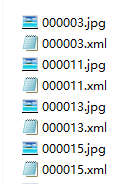1、目的
有些时候,我们获取到的数据场景有限,且感兴趣目标在原图所占比例太小,或者目标的位置不平衡(如:大多数目标都在图像中间,边缘的目标几乎没有)。
那么,我们就需要对原始的数据集进行一些数据增强,除了常见的平移、旋转、裁剪、调整亮度等,处理上述问题的一个有效方法就是把不同的图片拼接起来,这样,就可以把各个目标强行拉到中心点之外,这就解决了位置不均衡的问题;而在拼接之前,对目标之外的背景部分进行裁剪,则可以是目标在整个图片中的占比提高,这就解决了原图目标太小,大部分都是背景的问题。
拼接后的效果如下:

2、裁剪并拼接——Crop and Joint代码
下面是完整的代码,只需要指定两个参数:raw_data_path、new_data_path,分别为原始数据集路径和增强后的数据存放路径。
其中,原始数据集是图片、xml文件存放到同一个文件夹下的,形如:

"""
Crop and joint for two or more images, so that get a new image include their target boxes.
"""
import numpy as np
import random
import xml.etree.ElementTree as ET
import cv2
import os
import argparse
from bboxes2xml import bboxes2xml
def list_dir(path, list_name, suffix='xml'): # 传入存储的list
for file in os.listdir(path):
file_path = os.path.join(path, file)
if os.path.isdir(file_path):
list_dir(file_path, list_name)
else:
if file_path.split('.')[-1] == suffix:
file_path = file_path.replace('\\', '/')
list_name.append(file_path)
def get_bboxes(xml_path):
tree = ET.parse(open(xml_path, 'rb'))
root = tree.getroot()
bboxes, cls = [], []
for obj in root.iter('object'):
obj_cls = obj.find('name').text
xmlbox = obj.find('bndbox')
xmin = float(xmlbox.find('xmin').text)
xmax = float(xmlbox.find('xmax').text)
ymin = float(xmlbox.find('ymin').text)
ymax = float(xmlbox.find('ymax').text)
bboxes.append([xmin, ymin, xmax, ymax])
cls.append(obj_cls)
bboxes = np.asarray(bboxes, np.int)
return bboxes, cls
def crop_img(img_path, xml_path):
img = cv2.imread(img_path)
h_img, w_img, _ = img.shape
bboxes, cls = get_bboxes(xml_path)
# 当图中无Bbox时,将长边裁剪到与短边等长
if len(cls) == 0:
diff_half = abs(h_img-w_img)//2
if h_img >= w_img:
img = img[diff_half:-diff_half, :, :]
else:
img = img[:, diff_half:-diff_half, :]
return img, bboxes, cls
# 得到可以包含所有bbox的最大bbox
max_bbox = np.concatenate([np.min(bboxes[:, 0:2], axis=0),
np.max(bboxes[:, 2:4], axis=0)], axis=-1)
# 随机crop,并保证crop后的img仍包含max_bbox
# top crop:
top_crop_total = max(max_bbox[1] - 10, 0)
top = random.randint(0, top_crop_total)
# left crop:
left_crop_total = max(max_bbox[0] - 10, 0)
left = random.randint(0, left_crop_total)
# down crop:
down_crop_total = max(h_img-max_bbox[3] - 10, 0)
down = random.randint(0, down_crop_total)
# right crop:
right_crop_total = max(w_img-max_bbox[2] - 10, 0)
right = random.randint(0, right_crop_total)
# 得到crop后的子图在原图中的范围
x1, y1, x2, y2 = left, top, w_img-right, h_img-down
# crop img and bboxes
img = img[y1:y2, x1:x2, :]
bboxes[:, [0, 2]] = bboxes[:, [0, 2]] - x1
bboxes[:, [1, 3]] = bboxes[:, [1, 3]] - y1
return img, bboxes, cls
def joint_imgs(img1, bboxes1, cls1, img2, bboxes2, cls2):
# 设置合并后的图片尺寸
W = img1.shape[1] + img2.shape[1]
H = max(img1.shape[0], img2.shape[0])
# zero img
img = np.zeros((H, W, 3), dtype=np.uint8)
# joint imgs
img[0:img1.shape[0], 0:img1.shape[1]] = img1
img[0:img2.shape[0], img1.shape[1]:] = img2
cls = cls1 + cls2
if len(cls2) != 0:
bboxes2[:, [0, 2]] = bboxes2[:, [0, 2]] + img1.shape[1]
if len(cls1) == 0:
return img, bboxes2, cls
else:
bbxes = np.vstack((bboxes1, bboxes2))
return img, bbxes, cls
else:
if len(cls1) == 0:
return img, bboxes2, cls
else:
return img, bboxes1, cls
def vis_bboxes(filename, img, bboxes, cls, if_print=False):
if if_print:
print("filename:{}\nbboxes:{}\nclasses:{}".format(filename, bboxes, cls))
for j, p in enumerate(bboxes):
[x1, y1, x2, y2] = p[:4]
cv2.rectangle(img, (x1, y1), (x2, y2), (0, 0, 255))
cv2.putText(img, cls[j], (x1, y1 + 10), cv2.FONT_HERSHEY_PLAIN, 1,
[0, 0, 255], 1)
cv2.imwrite('crop_vis/' + filename.split('/')[-1], img)
def test_crop(args):
xmls = []
list_dir(args.raw_data_path, xmls, suffix='xml')
imgs = [xml.replace('.xml', '.jpg') for xml in xmls]
xml1 = random.choice(xmls)
xml2 = random.choice(xmls)
img1 = xml1.replace('.xml', '.jpg')
img2 = xml2.replace('.xml', '.jpg')
img1_crop, bboxes1_crop, cls1 = crop_img(img1, xml1)
img2_crop, bboxes2_crop, cls2 = crop_img(img2, xml2)
img, bbxes, cls = joint_imgs(img1_crop, bboxes1_crop, cls1, img2_crop, bboxes2_crop, cls2)
# 可视化并保存
# vis_bboxes(img1, img1_crop, bboxes1_crop, cls1)
# vis_bboxes(img2, img2_crop, bboxes2_crop, cls2)
vis_bboxes('joint.jpg', img, bbxes, cls)
def main(args):
os.makedirs(args.new_data_path, exist_ok=True)
xmls = []
list_dir(args.raw_data_path, xmls, suffix='xml')
# imgs = [xml.replace('.xml', '.jpg') for xml in xmls]
for i, xml in enumerate(xmls):
xml1 = xml
xml2 = random.choice(xmls)
img1 = xml1.replace('.xml', '.jpg')
img2 = xml2.replace('.xml', '.jpg')
img1_crop, bboxes1_crop, cls1 = crop_img(img1, xml1)
img2_crop, bboxes2_crop, cls2 = crop_img(img2, xml2)
img, bboxes, cls = joint_imgs(img1_crop, bboxes1_crop, cls1, img2_crop, bboxes2_crop, cls2)
# save crop-joint img-xml pairs to new dataset path
joint_name = 'joint_'+img1.split('/')[-1].replace('.jpg', '')
img_save_path = os.path.join(args.new_data_path, joint_name+'.jpg')
cv2.imwrite(img_save_path, img)
gts = [[c]+b.tolist() for c, b in zip(cls, bboxes)]
bboxes2xml(folder=args.new_data_path.split('/')[-1], img_name=joint_name,
width=img.shape[1], height=img.shape[0],
gts=gts, xml_save_to=args.new_data_path)
# visualize crop_joint imgs
vis_bboxes(joint_name+'.jpg', img, bboxes, cls, if_print=True)
def parse_args():
parser = argparse.ArgumentParser()
parser.add_argument("--raw_data_path", default="path to raw_data_path", type=str,
help="raw dataset files")
parser.add_argument("--new_data_path", default="path to new_data_path", type=str,
help="generated new dataset files")
return parser.parse_args()
if __name__ == '__main__':
args = parse_args()
main(args)
# test_crop(args)